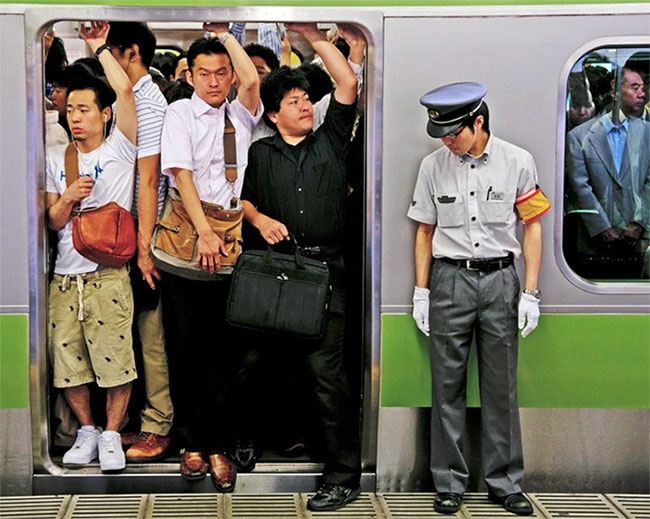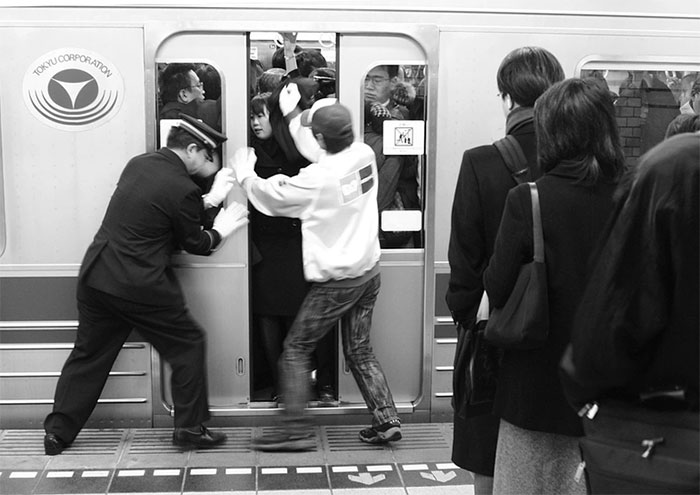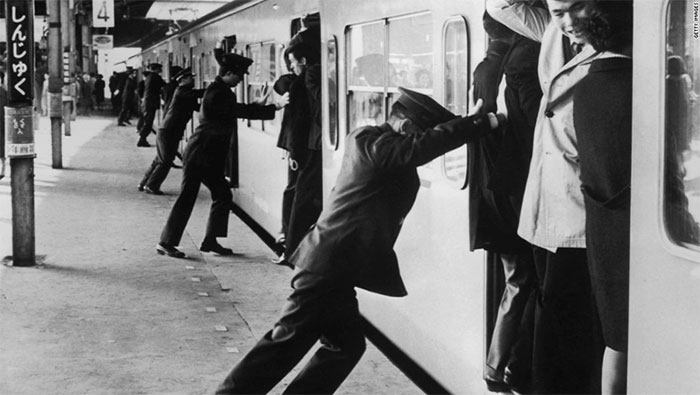The invention of the 'train pusher' and the reason why trains in Japan exceed 200% of capacity

Subways in major cities in Japan are extremely crowded.
The railway network in Japan is known the world over for its excellence and punctuality. In the capital Tokyo, an average of nearly 40 million passengers travel by rail every day, much higher than other means of transport such as buses or personal cars. Of this number, 22% - or 8.7 million people use the subway.
On most lines, trains arrive and leave an average of 5 minutes apart and during peak times they tend to meet passenger demand in 2-3 minutes. So on average, there are about 24 trains per hour in the same direction.
Although there are many trains that are rotated, subways in major cities in Japan are still extremely crowded, especially during rush hour.
According to a statistics from the Ministry of Land, Infrastructure and Transport in Japan, almost all trains in Tokyo are running at capacity. In which, a few run more than 200% of the rated capacity.


Image of "Oshiya" or "train pushers" at Shinjuku Station, Tokyo trying to fit as many passengers as possible into the car during rush hour 1967.
To accommodate double, or even triple the number of passengers on a subway car, stations employ uniformed staff known as "oshiya" or "pushers", with the goal of is to cram as many people into the subway car as possible.
When "train pushers" were first introduced at Tokyo's Shinjuku Station, they were known as "passenger handlers", mostly part-time students. Today, however, any station worker will become a professional "pusher", ready to take on this role during rush hour.
Although quite popular in Japan, the concept of "train pusher" is an American invention and originated in New York City, nearly a century ago. However, this work gradually became obsolete when trains introduced automatic door technology, making it impossible to "cram" passengers when it was time to depart.
In 2012, Hong Kong-based photographer Michael Wolf created a series of photos called Tokyo Compression, showing the painful and uncomfortable expressions of passengers as their faces were smashed against the door, pressed against the window due to the jostling. Welcome to the train compartments.
These photos show how horrible and shameful the situation inside the subway has become. Passengers with their bodies pressed together so tightly that most people cannot move, short people and small children are at risk of suffocation by the layers of the surrounding passengers.

Passengers with their bodies pressed so tightly together that most people cannot move in Japan.
Getting off the train at the right station also requires the strength and determination of passengers. Overcrowding also makes it difficult for them to handle a fire or emergency evacuation situation. The subway is also a "fertile ground" for pickpockets and harassers to carry out their acts.
Although there are many bad sides, but it is undeniable that the way "cramming" helps significantly increase the operating capacity of electric trains, especially in densely populated cities with dense traffic.
In 2017, the city government of Madrid, Spain was inspired by the Japanese and hired a "train pusher" to deal with a spike in passenger numbers due to one of the tram lines being temporarily closed because of public transport. maintenance.
- India trains run by solar energy
- Japan tests super-speed train running on the magnetic buffer
- It can only be Japan: The train knows how to fake dogs and deer to prevent accidents
- The reason Japanese trainers sat on the tracks watching trains run
- Video: Japan runs passenger trains at a speed of 500km / h
- Mysterious encounters between UFOs and trains
- High-speed trains close to the ground
- Nhon-Hanoi Urban Railway has been testing trains since September 2020
- Japan launches bio-diesel train
- South Korea develops next-generation high-speed trains
- 'Green' trains in Europe
- Germany is keen on using hydrogen fuel trains next year
 Daily use inventions come from universities
Daily use inventions come from universities Special weight loss device helps prevent appetite
Special weight loss device helps prevent appetite 8 inventors were killed by their own inventions
8 inventors were killed by their own inventions Iran invented a motor car powered by water
Iran invented a motor car powered by water The world's longest driverless metro system
The world's longest driverless metro system  Aviation students create smart boxes to guide passengers at the airport
Aviation students create smart boxes to guide passengers at the airport  Future travel: Fly in a giant hot air balloon in the stratosphere but the price is super expensive, $ 50,000 / ticket
Future travel: Fly in a giant hot air balloon in the stratosphere but the price is super expensive, $ 50,000 / ticket  Why not yawn when passing through security at the airport?
Why not yawn when passing through security at the airport?  How is the virus spread if you share a plane with an ill person?
How is the virus spread if you share a plane with an ill person?  Should headphones be worn at the time of take-off and landing?
Should headphones be worn at the time of take-off and landing? 